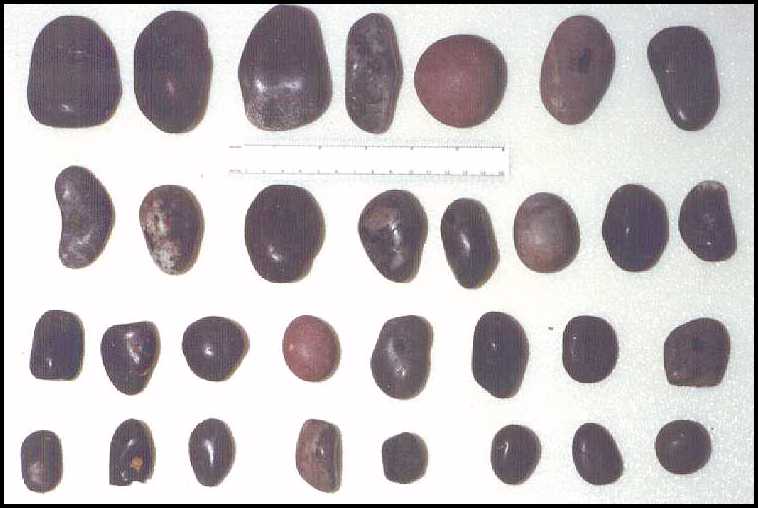

Markings(?) on Gastroliths
The two gastroliths shown below came from two different times and two different plesiosaur specimens... KUVP 1318 (1st from the left, second row, above) was found in Ellsworth County, Kansas (Carlile Fm?, ~ 92 mya?) and was described by S.W. Williston over a hundred years ago. The South Dakota gastrolith is also in the KU collection but is probably from the Pierre Shale of western South Dakota ( ~ 75 mya). Both stones have identical 'arc' shaped markings (conchoidal fractures), about between 1 and 2 mm long. The markings are easily viewed under a binocular microscope... lighting for a photograph is a bit more difficult. Several different lighting angles were used to highlight the markings.
CLICK TO TO VIEW PICTURE:
| KUVP 1318-2 | SD-Gast1 | |
| SD-Gast2 | SD-Gast3 | SD-Gast4 |
The markings are randomly oriented around the entire surface of the stone. Not all gastroliths from the same specimen show these markings. I suspect that the gastrolith has to been pressed against another stone to cause the conchoidal fractures, and I am curious as to what motions the contractions of a muscular stomach or crop would produce on the contents, including the gastroliths. Most of these gastroliths are composed of chert, but the KUVP 1318 gastrolith is of metamorphic origin... it contains the fossils of small invertebrates. Some of the other gastroliths from each specimen are quartz or quartzite.
Addendum: Since this page was created, I've found the same markings on gastroliths from 6 different plesiosaurs, from Texas, Kansas, Nebraska and South Dakota.
SUGGESTED REFERENCES:
Everhart, M. J. 2004. Conchoidal fractures preserved on elasmosaur gastroliths are evidence of use in processing food. Journal of Vertebrate Paleontology 24 (Supplement to 3): 56A.
Everhart, Michael J. 2005. Oceans of Kansas - A Natural History of the Western
Interior Sea. Indiana University Press, 322 pp.
Everhart, M.J. 2005. Probable plesiosaur gastroliths from the basal Kiowa Shale (Early
Cretaceous) of Kiowa County, Kansas. Kansas Academy of Science, Transactions 108 (3/4):
109-115.
Everhart, M. J. 2005. Elasmosaurid remains from the Pierre Shale (Upper Cretaceous) of
western Kansas. Possible missing elements of the type specimen of Elasmosaurus
platyurus Cope 1868? PalArch 4(3): 19-32.
Kubo, T., Mitchell, M.T. and Henderson, D.M. 2012. Albertonectes vanderveldei, a new elasmosaur (Reptilia, Sauropterygia) from the Upper Cretaceous of Alberta. Journal of Vertebrate Paleontology 32(3):557-572.
Schmeisser,
R.L. and Gillette, D.D. 2009. Unusual
occurrence of gastroliths in a polycotylid plesiosaur from the Upper Cretaceous Tropic
Shale, southern
Shimada, K., Tsuihiji, T., Sato, T. and
Hasegawa, Y. 2010. A remarkable case of a shark-bitten elasmosaurid plesiosaur.
Journal of Vertebrate Paleontology 30(2):592-597.
Thompson, W. A., Martin, J. E. and Reguero, M. 2007. Comparison of gastroliths within plesiosaurs (Elasmosauridae) from the Late Cretaceous marine deposits of Vega Island, Antarctic Peninsula, and the Missouri River area, South Dakota. Pages 147-153 in Martin, J. E. and Parris D. C. (eds.), The Geology and Paleontology of the Late Cretaceous Marine Deposits of the Dakotas. Geological Society of America, Special Paper 427.